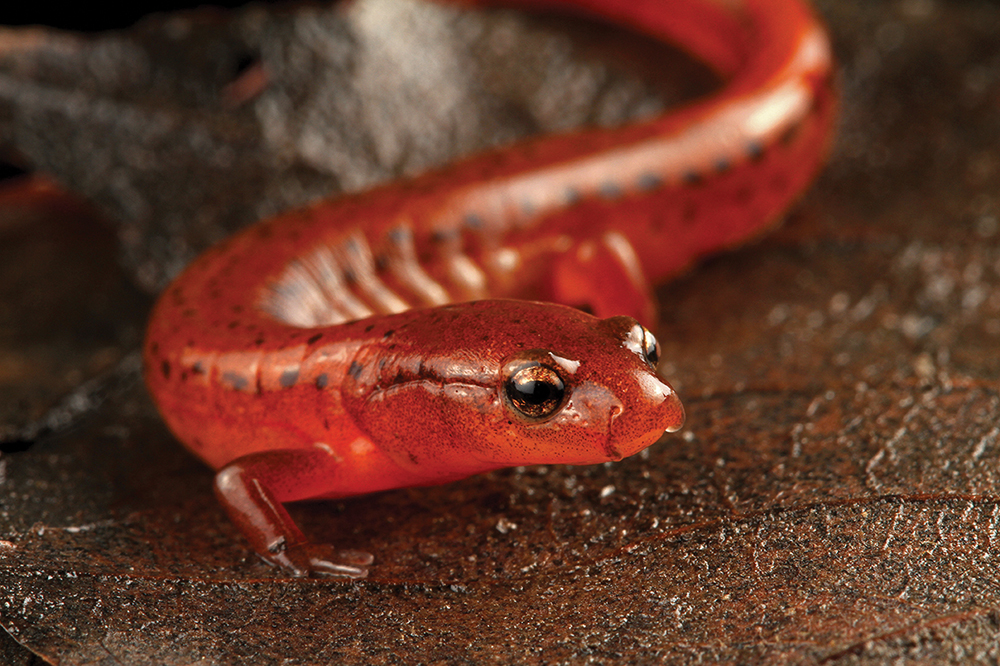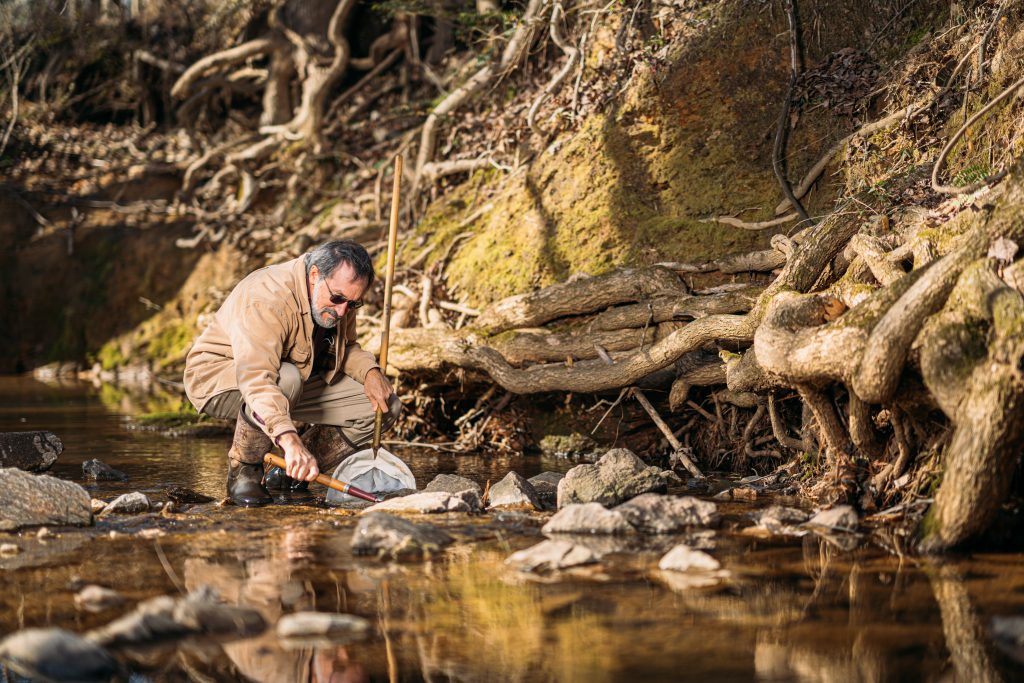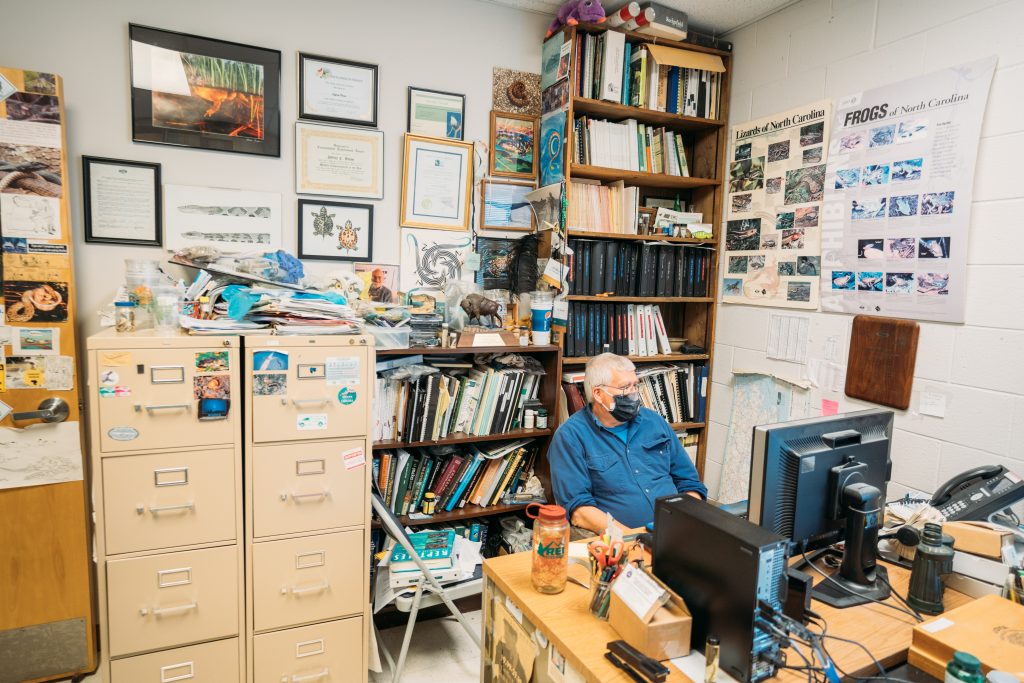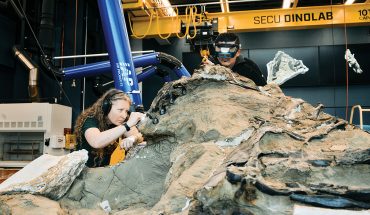Discovered decades ago, the Carolina Sandhills Salamander was recently proven to be an entirely new species.
by Hampton Williams Hofer / photography by Justin Kase Condor

“I thought it was just an oddball,” says Alvin Braswell of the unusual red salamander he first saw in 1969.
At the time, he was the assistant curator for lower invertebrates at the North Carolina Museum of Natural Sciences. It looked like a Southern Two-Lined Salamander (Eurycea cirrigera), but “the specimen had hardly any stripes, it was different — and it alerted us to pay more attention.”
Braswell went on to spend many rainy nights along streams “all over” the Sandhills, burrowing through root tangles in search of more of these salamanders. He learned to find them on roadsides, where they tended to move on damp winter nights — little streaks on the asphalt, indistinguishable from pine needles when their heads were down.
Five decades later, that “oddball” red salamander is now known officially as the Carolina Sandhills Salamander (Eurycea arenicola). It marks the 64th salamander species for North Carolina.
“It’s exciting because it adds yet another species to a state which already boasts the highest salamander diversity in the United States — and possibly of any similar-sized region in the world,” says Jeff Beane, collections manager for herpetology at the NCMNS.

Almost every known specimen of the Carolina Sandhills Salamander is housed in the NCMNS’s collection — but you won’t find them downtown. In the summer of 1998, the ethanol-preserved specimens were moved from the museum’s basement to the Prarie Ridge Ecostation & Research Laboratory near Reedy Creek Road, since such a large volume of flammable liquid beneath a public building downtown posed serious safety concerns.
Today, the 20,000-square-foot lab holds more than two million fluid-preserved, research grade specimens of invertebrates, fishes, amphibians, reptiles, birds, and mammals, some of which were collected in the late 1800s.
“Those collections are invaluable for documenting the biodiversity of not only North Carolina, but other regions as well,” says Beane. “The lab houses the world’s largest collections of many species, and its regional representation is among the strongest of any collection in the world.”
The new categorization of the Carolina Sandhills Salamander is thanks to significant advancements in DNA analysis — and some serious team effort. When Braswell, who currently serves as the interim deputy director of the museum, turned his work over to Bryan Stuart, research curator for herpetology in 2008, he knew Stuart would run with it.
“Bryan has feet in both traditional and modern techniques of DNA analysis,” says Braswell. “He’s done a wonderful job showing that this salamander is unique.”
Thanks to a Research Opportunity Award grant from the U.S. National Science Foundation in 2016, Stuart’s team used a next-generation machine called an Illumina MiSeq to sequence the salamander’s DNA. The results showed that it differed from previously known species in both the mitochondrial and nuclear genome.
Sequencing was no small task, as separate populations and species of two lined salamanders have come in contact many times during their evolutionary histories. “As a result of gene exchange among members of this species complex, a larger number of genes than usual were needed to disentangle their evolutionary history and show that the Carolina Sandhills Salamander does indeed have the distinct evolutionary lineage to be called a distinct species,” Stuart explains.


North Carolina’s 64 species of salamanders reflect the history of a state that has never been a desert and never been glaciated — it’s remained a stable area with a variety of habitats. But there is still discovery to be done in our own backyards: the Carolina Sandhills Salamander is the third new species to be described in North Carolina in the past year, and the research continues.
“While some may tend to believe all our local biodiversity has been discovered by now and that new discoveries await only in remote corners of the globe, that is far from true,” says Beane. “Genetics have become a strong tool for teasing out the true relationships of organisms that we only thought we knew.”
Stuart calls the North Carolina Museum of Natural Sciences “an aggregation of kindred spirits who share a fascination with the natural world around us.” This network of devoted and curious minds is hard at work researching, engaging the community, and uncovering new details about life on earth.
“Sorting out who’s who out there in the wild is fascinating,” says Braswell. “And this isn’t the last discovery. Not by any means.”

This article originally appeared in the March 2021 issue of WALTER magazine.



